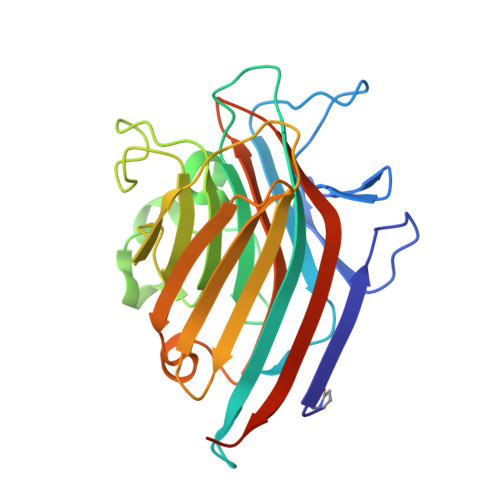Structural Basis of Oligomannose Recognition by the Pterocarpus angolensis Seed Lectin
Loris, R., Van Walle, I., De Greve, H., Beeckmans, S., Deboeck, F., Wyns, L., Bouckaert, J.(2004) J Mol Biology 335: 1227-1240
- PubMed: 14729339
- DOI: https://doi.org/10.1016/j.jmb.2003.11.043
- Primary Citation of Related Structures:
1Q8O, 1Q8P, 1Q8Q, 1Q8S, 1Q8V, 1UKG - PubMed Abstract:
The crystal structure of a Man/Glc-specific lectin from the seeds of the bloodwood tree (Pterocarpus angolensis), a leguminous plant from central Africa, has been determined in complex with mannose and five manno-oligosaccharides. The lectin contains a classical mannose-specificity loop, but its metal-binding loop resembles that of lectins of unrelated specificity from Ulex europaeus and Maackia amurensis. As a consequence, the interactions with mannose in the primary binding site are conserved, but details of carbohydrate-binding outside the primary binding site differ from those seen in the equivalent carbohydrate complexes of concanavalin A. These observations explain the differences in their respective fine specificity profiles for oligomannoses. While Man(alpha1-3)Man and Man(alpha1-3)[Man(alpha1-6)]Man bind to PAL in low-energy conformations identical with that of ConA, Man(alpha1-6)Man is required to adopt a different conformation. Man(alpha1-2)Man can bind only in a single binding mode, in sharp contrast to ConA, which creates a higher affinity for this disaccharide by allowing two binding modes.
Organizational Affiliation:
Laboratorium voor Ultrastructuur, Instituut voor Moleculaire Biologie, Building E, Vrije Universiteit Brussel and Vlaams Instituut voor Biotechnologie, Pleinlaan 2, B-1050 Brussel, Belgium. reloris@vub.ac.be






















